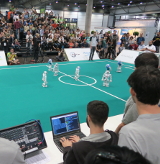Selective Visual Attention for Object Detection on a Legged Robot
Selective Visual Attention for Object Detection on a Legged Robot.
Daniel
Stronger and Peter Stone.
In Gerhard Lakemeyer, Elizabeth
Sklar, Domenico Sorenti, and Tomoichi Takahashi, editors, RoboCup-2006: Robot Soccer World Cup X, Lecture Notes
in Artificial Intelligence, pp. 158–170, Springer Verlag, Berlin, 2007.
Some videos
referenced in the paper.
Download
[PDF]159.7kB [postscript]342.4kB
Abstract
Autonomous robots can use a variety of sensors, such as sonar, laser range finders, and bump sensors, to sense their environments. Visual information from an onboard camera can provide particularly rich sensor data. However, processing all the pixels in every image, even with simple operations, can be computationally taxing for robots equipped with cameras of reasonable resolution and frame rate. This paper presents a novel method for a legged robot equipped with a camera to use selective visual attention to efficiently recognize objects in its environment. The resulting attention-based approach is fully implemented and validated on an Aibo ERS-7. It effectively processes incoming images 50 times faster than a baseline approach, with no significant difference in the efficacy of its object detection.
BibTeX Entry
@incollection(LNAI2006-dan,
author="Daniel Stronger and Peter Stone",
title="Selective Visual Attention for Object Detection on a Legged Robot",
booktitle= "{R}obo{C}up-2006: Robot Soccer World Cup {X}",
Editor="Gerhard Lakemeyer and Elizabeth Sklar and Domenico Sorenti and Tomoichi Takahashi",
Publisher="Springer Verlag",address="Berlin",year="2007",
issn="0302-9743",
isbn="978-3-540-74023-0",
series="Lecture Notes in Artificial Intelligence",
volume="4434",
pages="158--170",
abstract={
Autonomous robots can use a variety of sensors, such
as sonar, laser range finders, and bump sensors, to
sense their environments. Visual information from
an onboard camera can provide particularly rich
sensor data. However, processing all the pixels in
every image, even with simple operations, can be
computationally taxing for robots equipped with
cameras of reasonable resolution and frame rate.
This paper presents a novel method for a legged
robot equipped with a camera to use selective visual
attention to efficiently recognize objects in its
environment. The resulting attention-based approach
is fully implemented and validated on an Aibo ERS-7.
It effectively processes incoming images 50 times
faster than a baseline approach, with no significant
difference in the efficacy of its object detection.
},
)



